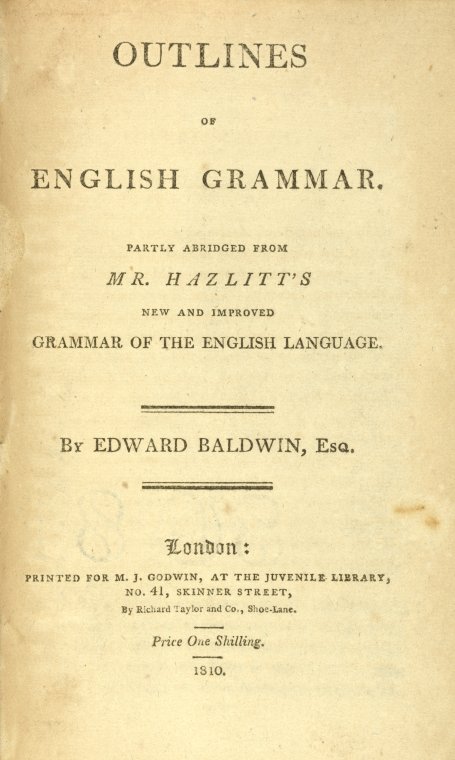Godwin’s Grammar
The Carl H. Pforzheimer Collection of (poet Percy Bysshe) Shelley and his Circle contains many of the greatest hits of British Romanticism—from holograph poems by Shelley, Byron, and Coleridge, to first editions of Mary Shelley’s Frankenstein. Yet Pforzheimer, an American financier who began collecting in the 1920s, widened the circle of his interests well beyond the literary canon, to include items as diverse as scientific treatises, almanacs, dictionaries, grammars, political pamphlets, and etiquette manuals. As I discovered, the Collection houses two little-known grammar books: one by William Hazlitt, A New and Improved Grammar of the English Tongue, for the Use of Schools (1810); and, published later that same year, Godwin’s Outlines of English Grammar, which he attributes to one of his pseudonyms, Edward Baldwin.
My dissertation, Deviant Standards in British Writing of the Long Romantic Period, focuses on how eighteenth- and early nineteenth- century discussions of English grammar contribute to our understanding of the emergent theories of literary genre in the period. As I prepared to visit the Pforzheimer, my list of must-see items grew. Although my priority was to see Godwin’s explicit writings on grammar, I thought it would also be useful to examine first and early editions of his fiction and nonfiction for signs of his nascent grammatical thought. I am interested in Godwin’s use of the subjunctive mood, which was a contested and confusing category for eighteenth century grammarians. I especially wanted to look for revisions or omissions of the subjunctive in later editions of Godwin’s 1794 novel, Caleb Williams. While I did not find any striking adjustments to the subjunctive, I was able to confirm that Godwin did not reduce the number of subjunctive phrases in the novel, even though he omitted or reworded other kinds of phrases.
The Hazlitt and Godwin grammars were the stars of my research visit. First, they were adorably smaller than I was expecting, like infant creatures, appropriately sized for young readers or the adult pocket. Second, they opened new avenues of thought for my dissertation, for which I am immensely grateful. Godwin first commissioned the Hazlitt grammar for his Juvenile Library—the bookshop he ran with his second wife, M.J. Godwin. Perhaps not entirely satisfied with Hazlitt’s account, Godwin appended to it “A New Guide to the English Tongue,” which he put in the form of a letter to another lexicographer, W. F. Mylius, author of the School Dictionary. In this letter, and in the subsequent grammar (Outlines), Godwin lays out a theory of grammar that departs from the prevailing approach to the structure of the English language at the time. By way of introduction he writes that he will “lay before you at once various specimens of the genuine declensions of the English tongue.”[1] It is striking that Godwin claims a genuine, rather than a derivative, system of declensions for English, a language of low-inflection compared to the heavily inflected languages of Latin and ancient Greek. He argues, furthermore, that the rules governing these genuine declensions will be just as “salutary” for “disciplining the young ideas” as the more ancient grammars.[2] By organizing grammar such that a substantive is related to the verbs and adjectives that branch away from it—like a family—instead of separated out according to word kind, Godwin imagines that students will gain a more holistic sense of the mutual affections of English words. Godwin’s views of grammar contribute invaluably to the layout of eighteenth-century and Romantic period conversations about the study of the English language. I suspect they will also offer new angles for approaching questions of rule-boundedness in the fiction and literary criticism of the period.
Read E-Books with SimplyE
 With your library card, it's easier than ever to choose from more than 300,000 e-books on SimplyE, The New York Public Library's free e-reader app. Gain access to digital resources for all ages, including e-books, audiobooks, databases, and more.
With your library card, it's easier than ever to choose from more than 300,000 e-books on SimplyE, The New York Public Library's free e-reader app. Gain access to digital resources for all ages, including e-books, audiobooks, databases, and more.
If you don’t have an NYPL library card, New York State residents can apply for a digital card online or through SimplyE (available on the App Store or Google Play).
Need more help? Read our guide to using SimplyE.
